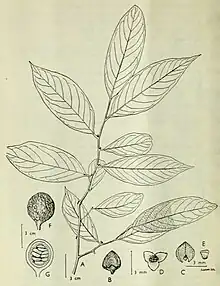| Pseuduvaria lignocarpa | |
|---|---|
 | |
| Botanical illustration of Pseuduvaria lignocarpa.[1] | |
| Scientific classification | |
| Kingdom: | Plantae |
| Clade: | Tracheophytes |
| Clade: | Angiosperms |
| Clade: | Magnoliids |
| Order: | Magnoliales |
| Family: | Annonaceae |
| Genus: | Pseuduvaria |
| Species: | P. lignocarpa |
| Binomial name | |
| Pseuduvaria lignocarpa | |
Pseuduvaria lignocarpa is a species of plant in the family Annonaceae.[2] It is native to New Guinea.[3] James Sinclair, the Scottish botanist who first formally described the species, named it after the woody (lignosus in Latin) wall of its fruit (Latinized form of Greek καρπoς, karpos).[1][4]
Description
It is a tree reaching 9 meters in height. The young, dark brown to black branches are sparsely hairy. Its elliptical to egg-shaped, leathery leaves are 11.5-19 by 3.5-6 centimeters. The leaves have pointed bases and tapering tips, with the tapering portion 10-20 millimeters long. The leaves are hairless on their upper and lower surfaces. The leaves have 10-16 pairs of secondary veins emanating from their midribs. Its sparsely hairy petioles are 6-11 by 1-2.5 millimeters with a narrow groove on their upper side. Its Inflorescences occur alone or in pairs on branches, and are organized on indistinct peduncles. Each inflorescence has up to 2 flowers. Each flower is on a densely hairy pedicel that is 2-3 by 0.3-1 millimeters. The pedicels are organized on a rachis up to 5 millimeters long that have 2 bracts. The pedicels have a medial, very densely hairy bract that is 0.5 millimeters long. Its flowers are unisexual. Its flowers have 3 free, oval sepals, that are 0.7-1 by 0.7-1 millimeters. The sepals are hairless on their upper surface, very densely hairy on their lower surface, and hairy at their margins. Its 6 petals are arranged in two rows of 3. The dull brown to olive-colored, oval, outer petals are 1.5-2 by 1.5-2 millimeters. The outer petals have hairless upper surfaces and densely hairy lower surfaces. The dark crimson to brown, diamond-shaped, inner petals have a 0.5-0.8 millimeter long claw at their base and a 2.5-3.5 by 2-2.5 millimeter blade. The inner petals have pointed bases and tips. The inner petals are hairless on their upper surfaces and densely hairy on their lower surfaces. Male flowers have 19-21 stamens that are 0.5-0.7 by 0.5-0.7 millimeters. The olive-colored fruit are attached by slightly hairy pedicles that are 8 by 2.5 millimeters. The fruit are elliptical and 47 by 40-46 millimeters. The fruit are smooth, and very densely hairy. Each fruit has up to 11 seeds in two rows. The lens-shaped, wrinkly seeds are 16-23.5 by 9.5-13 by 3.5-6 millimeters.[5]
Reproductive biology
The pollen of P. lignocarpa is shed as permanent tetrads.[6]
Habitat and distribution
It has been observed growing in lowland and submontane forests at elevations of 150-1370 meters.[5]
References
- 1 2 Sinclair, James (1956). "Notes on New Guinea Annonaceae, Part I". The Gardens' Bulletin, Singapore. 4. 15: 7. Retrieved July 12, 2021.
- ↑ "Pseuduvaria lignocarpa J. Sinclair". Catalogue of Life. Species 2000. n.d. Retrieved July 12, 2021.
- ↑ "Pseuduvaria lignocarpa J.Sinclair". Plants of the World Online. The Trustees of the Royal Botanic Gardens, Kew. n.d. Retrieved July 12, 2021.
- ↑ Stearn, William (2004). Botanical Latin. Portland, Ore. Newton Abbot: Timber Press David & Charles. ISBN 9780881926279.
- 1 2 Su, Yvonne C.F.; Saunders, Richard M.K. (2006). Monograph of Pseuduvaria (Annonaceae). Systematic Botany Monographs. Vol. 79. American Society of Plant Taxonomists. pp. 1–204. JSTOR 25027955.
- ↑ Su, Yvonne C. F.; Saunders, Richard M. K. (2003). "Pollen structure, tetrad cohesion and pollen-connecting threads in Pseuduvaria (Annonaceae)". Botanical Journal of the Linnean Society. 143 (1): 69–78. doi:10.1046/j.1095-8339.2003.00204.x. ISSN 1095-8339.